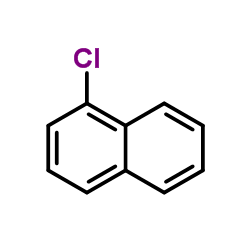Complete dechlorination of 1-chloronaphthalene by electrochemical reduction with naphthalene radical anion as mediator.
Atsushi Matsunaga, Akio Yasuhara
Index: Environ. Sci. Technol. 37(15) , 3435-41, (2003)
Full Text: HTML
Abstract
The possibility of electrochemical reduction for the complete dechlorination of toxic chlorinated aromatic compounds was investigated using 1-chloronaphthalene as a substrate. Sufficient current was obtained at the reduction potential of naphthalene rather than that of the substrate, and complete (>99.99%) dechlorination was achieved in tetra-n-butylammonium perchlorate/dimethylformamide solution in less than 1 h. The reaction was considered to proceed autocatalytically with the naphthalene radical anion, which was derived from the reduction of the initial dechlorination product (naphthalene) of the substrate, as mediator. The reaction rate was increased by the use of an excess of naphthalene at the start of the reaction, and complete dechlorination was possible without significant loss of current efficiency even if the water concentration was 0.3% v/v. The order of reaction of the mediated reduction was determined kinetically to be 0.5 for the substrate and 1 for naphthalene. Although the reaction of the naphthalene radical anion with 1-chloronaphthalene was very fast, it was considered to be the rate-determining step.
Related Compounds
| Structure | Name/CAS No. | Molecular Formula | Articles |
|---|---|---|---|
 |
1-Chloronaphthalene
CAS:90-13-1 |
C10H7Cl |
|
QSPR modeling of octanol/water partition coefficient for vit...
2008-04-01 [Eur. J. Med. Chem. 43 , 714-40, (2008)] |
|
Quantitative structure-activity relationship analysis of inh...
2005-01-27 [J. Med. Chem. 48 , 440-9, (2005)] |
|
Exploring QSAR and QAAR for inhibitors of cytochrome P450 2A...
2009-01-01 [Eur. J. Med. Chem. 44 , 1941-51, (2009)] |
|
Predictive three-dimensional quantitative structure-activity...
2005-06-02 [J. Med. Chem. 48 , 3808-15, (2005)] |
|
Effects of chlorinated aliphatic hydrocarbons on mitochondri...
1981-01-01 [Ind. Health 19(2) , 71-5, (1981)] |